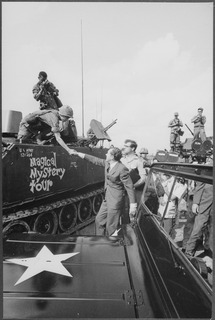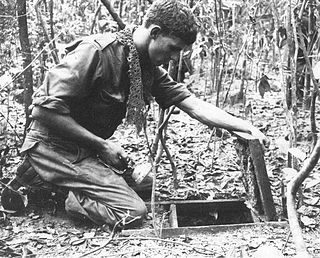
The Tet Offensive, or officially called The General Offensive and Uprising of Tet Mau Than 1968 by North Vietnam and the Viet Cong, was one of the largest military campaigns of the Vietnam War, launched on January 30, 1968, by forces of the Viet Cong and North Vietnamese People's Army of Vietnam against the forces of the South Vietnamese Army of the Republic of Vietnam, the United States Armed Forces, and their allies. It was a campaign of surprise attacks against military and civilian command and control centers throughout South Vietnam. The name of the offensive comes from the Tết holiday, the Vietnamese New Year, when the first major attacks took place.

The Cambodian Civil War was a military conflict that pitted the forces of the Communist Party of Kampuchea and their allies the Democratic Republic of Vietnam and the Viet Cong against the government forces of the Kingdom of Cambodia and, after October 1970, the Khmer Republic, which were supported by the United States (U.S.) and the Republic of Vietnam.

Vietnamization was a policy of the Richard Nixon administration to end U.S. involvement in the Vietnam War through a program to "expand, equip, and train South Vietnamese forces and assign to them an ever-increasing combat role, at the same time steadily reducing the number of U.S. combat troops." Brought on by the Viet Cong's Tet Offensive, the policy referred to U.S. combat troops specifically in the ground combat role, but did not reject combat by the U.S. Air Force, as well as the support to South Vietnam, consistent with the policies of U.S. foreign military assistance organizations. U.S. citizens' mistrust of their government that had begun after the offensive worsened with the release of news about U.S. soldiers massacring civilians at My Lai (1968), the invasion of Cambodia (1970), and the leaking of the Pentagon Papers (1971).

The tunnels of Củ Chi are an immense network of connecting tunnels located in the Củ Chi District of Ho Chi Minh City (Saigon), Vietnam, and are part of a much larger network of tunnels that underlie much of the country. The Củ Chi tunnels were the location of several military campaigns during the Vietnam War, and were the Viet Cong's base of operations for the Tết Offensive in 1968.

Operation Crimp, also known as the Battle of the Ho Bo Woods, was a joint US-Australian military operation during the Vietnam War, which took place 20 kilometres (12 mi) north of Cu Chi in Binh Duong Province, South Vietnam. The operation targeted a key Viet Cong headquarters that was believed to be concealed underground, and involved two brigades under the command of the US 1st Infantry Division, including the 1st Battalion, Royal Australian Regiment which was attached to the US 173rd Airborne Brigade. Heavy fighting resulted in significant casualties on both sides, but the combined American and Australian force was able to uncover an extensive tunnel network covering more than 200 kilometres (120 mi).

Military simulations, also known informally as war games, are simulations in which theories of warfare can be tested and refined without the need for actual hostilities. Many professional analysts object to the term wargames as this is generally taken to be referring to the civilian hobby, thus the preference for the term simulation.

The year 1968 saw major developments in the Vietnam War. The military operations started with an attack on a US base by the Vietnam People's Army (NVA) and the Viet Cong on January 1, ending a truce declared by the Pope and agreed upon by all sides. At the end of January, the North Vietnamese and the Viet Cong launched the Tet Offensive.

In 1965, the United States rapidly increased its military forces in South Vietnam, prompted by the realization that the South Vietnamese government was losing the Vietnam War as the communist-dominated Viet Cong gained influence over much of the population in rural areas of the country. North Vietnam also rapidly increased its infiltration of men and supplies to combat South Vietnam and the U.S.. The objective of the U.S. and South Vietnam was to prevent a communist take-over. North Vietnam and the insurgent Viet Cong sought to unite the two sections of the country.

South Vietnam was in political chaos during much of the year, as generals competed for power and Buddhists protested against the government. The Viet Cong communist guerrillas expanded their operations and defeated the South Vietnamese army (ARVN) in many battles. North Vietnam made a definitive judgement in January to assist the Viet Cong insurgency with men and material. In November, North Vietnam ordered the North Vietnamese Army to infiltrate units into South Vietnam and undertake joint military operations with the Viet Cong.
The Sigma war games were a series of classified high level war games played in the Pentagon during the 1960s to strategize the conduct of the burgeoning Vietnam War. The games were designed to replicate then-current conditions in Indochina, with an aim toward predicting future events in the region. In almost all runs, the outcome was either a communist win, or a stalemate that led to protests in the US.
Sigma I-63 was one of the series of Sigma war games. These were a series of classified high level war games played in the Pentagon during the 1960s to strategize the conduct of the burgeoning Vietnam War. These simulations were designed to replicate then-current conditions in Indochina, with an aim toward predicting future foreign affairs events. They were staffed with high-ranking officials standing in to represent both domestic and foreign characters; stand-ins were chosen for their expertise concerning those they were called upon to represent. The games were supervised by a Control appointed to oversee both sides. The opposing Blue and Red Teams customary in war games were designated the friendly and enemy forces as was usual; however, several smaller teams were sometimes subsumed under Red and Blue Teams. Over the course of the games, the Red Team at times contained the Yellow Team for the People's Republic of China, the Brown Team for the Democratic Republic of Vietnam, the Black Team for the Viet Cong, and Green for the USSR.
The Sigma I-65 war game was one of a series of classified high level war games played in The Pentagon during the 1960s to strategize the conduct of the burgeoning Vietnam War. These simulations were designed to replicate then-current conditions in Indochina, with an aim toward predicting future foreign affairs events. They were staffed with high-ranking officials standing in to represent both domestic and foreign characters; stand-ins were chosen for their expertise concerning those they were called upon to represent. The games were supervised by a Control appointed to oversee both sides. The opposing Blue and Red Teams customary in war games were designated the friendly and enemy forces as was usual; however, several smaller teams were sometimes subsumed under Red and Blue Teams. Over the course of the games, the Red Team at times contained the Yellow Team for the People's Republic of China, the Brown Team for the Democratic Republic of Vietnam, the Black Team for the Viet Cong, and Green for the USSR.
The Sigma I-66 war game was one of a series of classified high level war games played in The Pentagon during the 1960s to strategize the conduct of the burgeoning Vietnam War. Sigma I-66 was based on the unrealistic scenario of a famine-stricken and militarily diminished North Vietnam agreeing to de-escalate its war efforts. It ended with a hypothetical force of 100,000 Viet Cong still in South Vietnam.
The Sigma I-62 war game, played in February 1962, was the first of a series of classified high level war games played in the Pentagon during the 1960s to strategize the conduct of the burgeoning Vietnam War. These simulations were designed to replicate then-current conditions in Indochina, with an aim toward predicting future foreign affairs events. The conclusion drawn from Sigma I-62 was that American intervention in Vietnam would be unsuccessful.
The Sigma I-64 war game, one of the Sigma war games, was played from 6 to 9 April 1964. Its purpose was to test scenarios of escalation of warfare in Vietnam. After rigorous research into information needed to form a scenario, a simulation took place, with knowledgeable officials playing out the roles of actual government decision makers. Participants were drawn from the State Department, Department of Defense, the Central Intelligence Agency, and the Joint Chiefs of Staff. In Sigma I-64, the scenarios to be examined were the burgeoning Viet Cong insurgency in Vietnam, and the possible use of U.S. air power against it.
The Sigma II-64 war game was one of a series of classified high level war games played in The Pentagon during the 1960s to strategize the conduct of the burgeoning Vietnam War. The games were designed to replicate then-current conditions in Indochina, with an aim toward predicting future foreign affairs events. They were staffed with high-ranking officials standing in to represent both domestic and foreign characters; stand-ins were chosen for their expertise concerning those they were called upon to represent. The games were supervised by a Control appointed to oversee both sides. The opposing Blue and Red Teams customary in war games were designated the friendly and enemy forces as was usual; however, several smaller teams were sometimes subsumed under Red and Blue Teams. Over the course of the games, the Red Team at times contained the Yellow Team for the People's Republic of China, the Brown Team for the Democratic Republic of Vietnam, the Black Team for the Viet Cong, and Green for the USSR.
The Sigma II-65 war game was one of a series of classified high level war games played in the Pentagon during the 1960s to strategize the conduct of the burgeoning Vietnam War. It was held between 26 July and 5 August 1965. The games were designed to replicate then-current conditions in Indochina, with an aim toward predicting future foreign affairs events. They were staffed with high ranking officials standing in to represent both domestic and foreign characters; stand-ins were chosen for their expertise concerning those they were called upon to represent. The games were supervised by a Control appointed to oversee both sides. The opposing Blue and Red Teams customary in war games were designated the friendly and enemy forces as was usual; however, several smaller teams were sometimes subsumed under Red and Blue Teams. Over the course of the games, the Red Team at times contained the Yellow Team for the People's Republic of China, the Brown Team for the Democratic Republic of Vietnam, the Black Team for the Viet Cong, and Green for the USSR.
The Sigma I-67 and II-67 War Games were two of a series of classified high level war games played in the Pentagon during the 1960s to strategize the conduct of the burgeoning Vietnam War. The games were designed to replicate then-current conditions in Indochina, with an aim toward predicting future foreign affairs events. They were staffed with high-ranking officials standing in to represent both domestic and foreign characters; stand-ins were chosen for their expertise concerning those they were called upon to represent. The games were supervised by a Control appointed to oversee both sides. The opposing Blue and Red Teams customary in war games were designated the friendly and enemy forces as was usual; however, several smaller teams were sometimes subsumed under Red and Blue Teams. Over the course of the games, the Red Team at times contained the Yellow Team for the People's Republic of China, the Brown Team for the Democratic Republic of Vietnam, the Black Team for the Viet Cong, and Green for the USSR.

















